The TIMEleSS project aims at studying interfaces in the Earth’s mantle combining observations from seismology, mineral physics experiments, microstructures, and wave propagation modeling. It is supported through a bilateral grant, from the ANR in France and the DFG in Germany. The project is led by Sébastien Merkel and Nadège Hilairet at the Université de Lille, Christine Thomas and Carmen Sanchez-Valle from the Westfälische Wilhelms-Universität, Münster, and Sergio Speziale from the Deutsche GeoForschungsZentrum, Potsdam.
Project launch: March 2018
Duration: 36 months, extended until December 2022
Total ANR-DFG funding: 700 000 €The active research period of TIMEleSS is now over, but we are still working on our datasets and publications so stay tuned for more!
Latest news
On the Influence of Pressure, Phase Transitions, and Water on Large-Scale Seismic Anisotropy Underneath a Subduction Zone
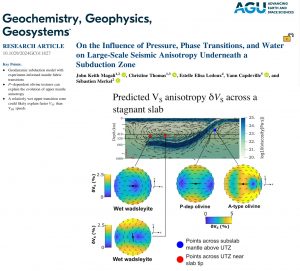 We have a new publication ! In his work published in AGU’s Geochemistry, Geophysics, Geosystems, J.K. Magali investigates the Influence of Pressure, Phase Transitions, and Water on Large-Scale Seismic Anisotropy Underneath a Subduction Zone.
We have a new publication ! In his work published in AGU’s Geochemistry, Geophysics, Geosystems, J.K. Magali investigates the Influence of Pressure, Phase Transitions, and Water on Large-Scale Seismic Anisotropy Underneath a Subduction Zone.
In fact, subduction deep inside the Earth’s mantle causes the surrounding mantle to deform according to the movement and pressure exerted by the plates. This influences the alignment of minerals making up the mantle, which in turn, affects the speed and direction of seismic waves known as seismic anisotropy.
In this publication, we investigate the role of pressure in the upper mantle and water in the transition zone on large‐scale seismic anisotropy across a subduction zone. In the upper mantle, we show that the patterns of anisotropy at places where deformation is presumed to be large are affected by changes in pressure. In the transition zone, anisotropy tends to favor a wetter environment.
Want to know more ? The full reference is here : Magali, J. K., Thomas, C., Ledoux, E. E., Capdeville, Y., & Merkel, S. (2025). On the influence of pressure, phase transitions, and water on large-scale seismic anisotropy underneath a subduction zone. Geochemistry, Geophysics, Geosystems, 26, e2024GC011827. https://doi.org/10.1029/2024GC011827.
Federica Defended her thesis!
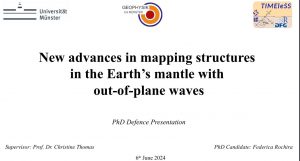 On June 6, 2024, Federic Rochira defended her thesis! She presented her work for 30 minutes, followed by 60 minutes of oral examination, in front of an international committee composed of Tine Thomas as first examiner, Sebastian Rost (University of Leeds) as second examiner, and Alexander Kappes (University of Münster) as third examiner.
On June 6, 2024, Federic Rochira defended her thesis! She presented her work for 30 minutes, followed by 60 minutes of oral examination, in front of an international committee composed of Tine Thomas as first examiner, Sebastian Rost (University of Leeds) as second examiner, and Alexander Kappes (University of Münster) as third examiner.
In her work, Federica investigated the presence of seismic structures in the Earth’s mantle and their effect on seismic wave paths, using a combination of seismic signals that are thought to travel along the predicted great circle path, between the source and the receiver, as well as signals traveling off the great circle path direction. To better constrain depth and location of mantle reflectors, she took into account directivity parameters of seismic signals, not yet widely used, as well as their traveltime.
Results show the advantages and necessity of using directivity information of seismic signals to detect regional-scale structures in the mantle associated with both subducted slabs and upwelling plumes, as well as mantle discontinuities. Ignoring the directional information, estimated location and depth of reflectors might be inaccurate and contribute to a misleading interpretation of mantle structures in terms of Earth’s dynamics and mineralogy.
She is now a Doctor of the University of Münster. Congratulations!
Seismic anisotropy of pyrolite in the Earth’s lower mantle
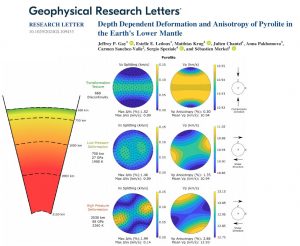 Yet another publication from the TIMEleSS team! Former TIMEleSS PhD student Jeff Gay has a new paper entitled Depth Dependent Deformation and Anisotropy of Pyrolite in the Earth’s Lower Mantle in the latest issue of Geophysical Research Letters.
Yet another publication from the TIMEleSS team! Former TIMEleSS PhD student Jeff Gay has a new paper entitled Depth Dependent Deformation and Anisotropy of Pyrolite in the Earth’s Lower Mantle in the latest issue of Geophysical Research Letters.
Seismologists rely on observable data to construct models that describe the dynamic state of the Earth’s lower mantle. These models, however, require constraints such as mantle composition and material behavior at high pressures and temperatures, which can be provided through experimental mineral physics.
In this study, we use a high pressure devices and X-rays to impose deformation and image the state of our sample with increasing pressure and temperature. We are able to extract information of individual mineral grains within our assemblage, such as the number of grains per phase and their orientations.
Using this experimental data, we identify three regimes of grain orientations in bridgmanite in the lower mantle, corresponding to
- transformation from lower pressure phases,
- deformation below ~50 GPa,
- deformation above ~50 GPa.
With this information, we are able to make predictions about how seismic waves travel and behave based on the deformation state of the lower mantle.
Pressure-dependent large-scale seismic anisotropy induced by non-Newtonian mantle flow
 Former TIMEleSS post-doc John Keith Magali has a new publication: Pressure-dependent large-scale seismic anisotropy induced by non-Newtonian mantle flow. The work was published in May 2024 in Geophysical Journal International.
Former TIMEleSS post-doc John Keith Magali has a new publication: Pressure-dependent large-scale seismic anisotropy induced by non-Newtonian mantle flow. The work was published in May 2024 in Geophysical Journal International.
In this work, John combines the team expertise in both mineral microstructures and seismic measurements to make predictions of seismic anisotropy development induced by mantle flow. In fact, observations of large-scale seismic anisotropy can be used as a marker for past and current deformation in the Earth’s mantle. Nonetheless, global features such as the decrease of the strength of anisotropy between ∼150 and 410 km in the upper mantle and weaker anisotropy observations in the transition zone remain ill-understood.
In this work, we integrate pressure-dependent microscopic flow properties in mantle minerals particularly olivine and wadsleyite into geodynamic simulations, compute the crystallographic preferred orientation and anisotropy in the upper mantle and upper transition zone, and apply a tomographic filter that accounts for finite-frequency seismic data, with the aim of providing mantle models comparable with seismic tomography observations.
Our results show that anisotropy observations in the upper mantle can be well understood by introducing gradual shifts in strain accommodation mechanism with increasing depths induced by a pressure-dependent plasticity model in olivine. Across the upper transition zone, our models predict reasonably low anisotropy, in agreement with observations.
These calculations show that, despite the relatively primitive geodynamic setup, models of plate-driven corner flows can be sufficient in explaining first-order observations of mantle seismic anisotropy. This requires, however, incorporating the effect of pressure on mineralogy and mineral plasticity models.
Partners
Partner institutions
 |
 |
 |
 |
Participating laboratories
 |
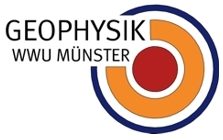 |
 |
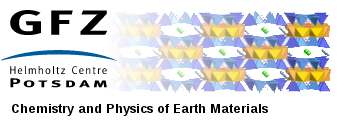 |
Funding bodies
 |
 |
 |
